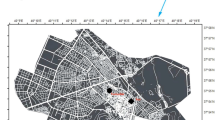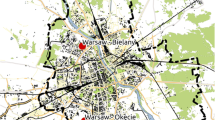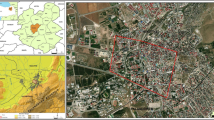Abstract
This paper offers a throughout human biometeorological assessment about the thermal conditions of Şanliurfa in one of the hottest parts of Turkey, in the hottest period of the year (from April to October), and a comparative analysis of three built-up types (urban, suburban and rural). Therefore, the values of physiologically equivalent temperature (PET), one of the most extensively used indices, were calculated from basic climate data with the help of the RayMan model. It was found by regarding the resulted mean PET values and the occurrence frequency of extreme heat stress periods (PET values above 41 °C) that the urban area exhibited the most unfavourable properties, followed by the suburban and rural areas. We also found very severe heat stress conditions in the summer, which may be explained by the torrid and arid climate, calm air conditions and the lack of abundant vegetation. Aiming to optimise human thermal conditions, thereby improving local life quality and facilitating international tourism, increment of vegetated areas and water surfaces would be required and, of course, highlighting the traditional methods taking into account the important aspects of sustainability.







Similar content being viewed by others
References
Abdel-Ghany AM, Al-Helal IM, Shady MR, Shad MR (2013) Human thermal comfort and heat stress in an outdoor urban arid environment: a case study, Advances in Meteorology, vol. 2013, Article ID 693541, 7 pages, 2013. doi:10.1155/2013/693541
Ali-Toudert F, Mayer H (2007) Effects of asymmetry, galleries, overhanging façades and vegetation on thermal comfort in urban street canyons. Sol Energy 81:742–754
ANSI/ASHRAE (2004) Standard 55-2004, thermal environmental conditions for human occupancy. ASHRAE, Atlanta
Azevedo PV, Bezerra PTC, Leitão MMVBR, Dos Santos CAC (2015) Characterization of human thermal comfort in urban areas of Brazilian semiarid. Revista Brasileira de Meteorologia 30(4):371–380. doi:10.1590/0102-778620140149
Bleta A, Nastos PT, Matzarakis A (2014) Assessment of bioclimatic conditions on Crete Island, Greece. Reg Environ Chang 14:1967–1981
Caliskan O, Cicek I, Matzarakis A (2012) The climate and bioclimate of Bursa (Turkey) from the perspective of tourism. Theor Appl Climatol 107(3–4):417–425 Retrieved from <Go to ISI>://WOS:00030008260007
Charalampopoulos I, Tsiros I, Chronopoulou-Sereli A, Matzarakis A (2013) Analysis of thermal bioclimate in various urban configurations in Athens, Greece. Urban Ecosyst 16:217–233
Çınar İ (1999) Fiziksel planlamada biyoklimatik veriler kullanarak biyokonforun oluşturulması üzerine Fethiye merkezi yerleşimi üzerinde araştırmalar Ege Üniversitesi Fen Bilimleri Enstitüsü Peyzaj Mimarlığı ABD. Yüksek Lisans Tezi. 101 s
Çınar İ (2004) Biyoklimatik konfor ölçütlerinin peyzaj planlama sürecinde etkinliği üzerinde Muğla-Karabağlar yaylası örneğinde araştırmalar. Ege Üniversitesi Fen Bilimleri Enstitüsü Peyzaj Mimarlığı ABD. Doktora Tezi
Cohen P, Potchter O, Matzarakis A (2012) Daily and seasonal climatic conditions of green urban open spaces in the Mediterranean climate and their impact on human comfort. Build Environ 51:285–295
de Freitas CR (2003) Tourism climatology: evaluating environmental information for decision making and business planning in the recreation and tourism sector. Int J Biometeorol 48:45–54
de Freitas CR, Scott D, McBoyle G (2008) A second generation climate index for tourism (CIT): specification and verification. Int J Biometeorol 52:399–407
Endler C, Matzarakis A (2011a) Climatic potential for tourism in the Black Forest, Germany—winter season. Int J Biometeorol 55:339–351
Endler C, Matzarakis A (2011b) Climate and tourism in the Black Forest during the warm season. Int J Biometeorol 55:173–186
Endler C, Oehler K, Matzarakis A (2010) Vertical gradient of climate change and climate tourism conditions in the Black Forest. Int J Biometeorol 54:45–61
Epstein Y, Moran DS (2006) Thermal comfort and the heat stress indices. Ind Health 44:388–398
Fanger PO (1972) Thermal comfort. McGraw-Hill, New York
Fröhlich D, Matzarakis A (2013) Modeling of changes in thermal bioclimate: examples based on urban spaces in Freiburg, Germany. Theor Appl Climatol 111:547–558
Gómez F, Pérez Cueva A, Valcuende M, Matzarakis A (2013) Research on ecological design to enhance comfort in open spaces of a city (Valencia, Spain). Utility of the physiologically equivalent temperature (PET). Ecol Eng 57:27–39
Grigorieva EA, Matzarakis A (2011) Physiologically equivalent temperature as a factor for tourism in extreme climate regions in the Russian Far East: preliminary results. European Journal of Tourism, Hospitality and Recreation 2:127–142
Gulyás Á (2009) Human-biometeorological assessments at different scales (in Hungarian: Humán bioklimatológiai értékelések különböző léptékű megközelítésben). PhD theses, Doctoral School of Earth Science, University of Szeged, 109 p. http://www2.sci.u-szeged.hu/fokozatok/PDF/Gulyas_Agnes/Gulyas_Agnes_PhD_tezisek_angol.pdf
Gulyás Á, Unger J, Matzarakis A (2006) Assessment of the microclimatic and human comfort conditions in a complex urban environment: modelling and measurements. Build Environ 41:1713–1722
Gulyás Á, Matzarakis A, Unger J (2010) Comparison of the urban–rural comfort sensation in a city with warm continental climate. Proceedings of BIOMET 7 473–479
Höppe P (1993) Heat balance modelling. Experientia 49:741–746
Höppe P (1999) The physiologically equivalent temperature—a universal index for the biometeorological assessment of the thermal environment. Int J Biometeorol 43:71–75
Huttner S, Bruse M, Dostal P (2008) Using ENVI-met to simulate the impact of global warming on the microclimate in central European cities. Ber Meteor Inst Albert-Ludwigs-Univ Freiburg 18:307–312
Hwang RL, Lin TP, Matzarakis A (2011) Seasonal effects of urban street shading on long-term outdoor thermal comfort. Build Environ 46:863–870
Jendritzky G, Nübler W (1981) A model analysing the urban thermal environment in physiologically significant terms. Arch Meteorol Geophys Bioclimatol B 29:313–326
Jendritzky G, Menz H, Schirmer H, Schmidt-Kessen W (1990) Methodik zur raumbezogenen Bewertung der thermischen Komponente im Bioklima des Menschen (Fortgeschriebenes Klima-Michel-Modell). Beitr Akad Raumforsch Landesplan, No. 114
Jendritzky G, Bröde P, Fiala D, Havenith G, Weihs P, Batchvarova E, de Dear R (2010) Der Thermische Klimaindex UTCI. Klimastatusbericht Deutscher Wetterdienst DWD, Offenbach
Kántor N, Unger J (2011) The most problematic variable in the course of human-biometeorological comfort assessment—the mean radiant temperature. Cent Eur J Geosci 3(1):90–100
Kántor N, Matzarakis A, Lin TP (2014) Daytime relapse of the mean radiant temperature based on the six-directional method under unobstructed solar radiation. Int J Biometeorol 58:1615–1625
Kántor N, Kovács A, Lin TP (2015) Looking for simple correction functions between the mean radiant temperature from the “standard black globe” and the “six-directional” techniques in Taiwan. Theor Appl Climatol 121:99–111
Kántor N, Kovács A, Takács Á (2016) Small-scale human-biometeorological impacts of shading by a large tree. Open Geosc. doi:10.1515/geo-2016-0021
Karaca M, Tayanç M, Toros M (1995) Effects of urbanization on climate of Istanbul and Ankara. Atmos Environ 29(23):3411–3421
Kovács A, Németh Á (2012) Tendencies and differences in human thermal comfort in distinct urban areas in Budapest, Hungary. Acta Climatologica Et Chorologica Universitatis Szegediensis, Tomus 46:115–124
Lee H, Holst J, Mayer H (2013) Modification of human-biometeorologically significant radiant flux densities by shading as local method to mitigate heat stress in summer within urban street canyons. Adv. Meteorol. Article ID 312572
Lin TP, Matzarakis A (2008) Tourism climate and thermal comfort in Sun Moon Lake, Taiwan. Int J Biometeorol 52:281–290
Lin T-P, Matzarakis A, Hwand R-L (2010) Shading effect on long-term outdoor thermal comfort. Build Environ 45:213–211
Matzarakis A (2007) Assessment method for climate and tourism based on daily data. In: A Matzarakis, CR de Freitas, D Scott (Eds) Developments in tourism climatology, 52–58
Matzarakis A, Amelung B (2008) Physiologically equivalent temperature as indicator for impacts of climate change on thermal comfort of humans. In: Thomson MC, Garcia-Herrera R, Beniston M (eds) Seasonal forecasts, climatic change and human health. Advances in global change research 30. Springer-Sciences and Business Media, Berlin, pp. 161–172
Matzarakis A, Mayer H (1996) Another kind of environmental stress: thermal stress. WHO Newsletter 18:7–10
Matzarakis A, Mayer H (1997) Heat stress in Greece. Int J Biometeorol 41:34–39
Matzarakis A, Mayer H, Izomon MG (1999) Application of a universal thermal index: physiologically equivalent temperature. Int J Biometeorol 43:76–84
Matzarakis A, Matuschek O, Neumcke R, Rutz F, Zalloom M (2007a) Climate change scenarios and tourism—how to handle and operate with data. In: Matzarakis A, de Freitas CR, Scott D Developments in tourism climatology, 240–245
Matzarakis A, Rutz F, Mayer H (2007b) Modelling radiation fluxes in simple and complex environments—application of the RayMan model. Int J Biometeorol 51:323–334
Matzarakis A, de Rocco M, Najjar G (2009) Thermal bioclimate in Strasbourg—the 2003 heat wave. Theor Appl Climatol 98:209–220
Matzarakis A, Rutz F, Mayer H (2010a) Modelling radiation fluxes in simple and complex environments—basics of the RayMan model. Int J Biometeorol 54:131–139
Matzarakis A, Rudel E, Zygmuntowski M, Koch E (2010b) Bioclimatic maps for tourism purposes. Phys Chem Earth 35:57–62
Mayer H, Höppe P (1987) Thermal comfort of man in different urban environments. Theor Appl Climatol 38:43–49
Mayer H, Kuppe S, Holst J, Imbery F, Matzarakis A (2009) Human thermal comfort below the canopy of street trees on a typical Central European summer day. H Mayer, A Matzarakis (eds) 5th Japanese-German Meeting on Urban Climatology. Ber. Meteor. Inst. Univ. Freiburg Nr. 18, 211–219
Müller N, Kuttler W, Barlag AB (2014) Counteracting urban climate change: adaptation measures and their effect on thermal comfort. Theor Appl Climatol 115:243–257
Nikolopoulou M, Lykoudis S (2007) Use of outdoor spaces and microclimate in a Mediterranean urban area. Build Environ 42:3691–3707
Rodríguez Algeciras JA, Matzarakis A (2016) Quantification of thermal bioclimate for the management of urban design in Mediterranean climate of Barcelona, Spain. Int J Biometeorol 60:1261
Shashua-Bar L, Pearlmutter D, Erell E (2011) The influence of trees and grass on outdoor thermal comfort in a hot-arid environment. Int J Climatol 31:1498–1506
Spagnolo J, de Dear R (2003a) A field study of thermal comfort in outdoor and semi-outdoor environments in subtropical Sydney Australia. Build Environ 38:721–738
Spagnolo J, de Dear R (2003b) A human thermal climatology of subtropical Sydney. Int J Climatol 23:1383–1395
Steadman RG (1971) Indices of windchill of clothed persons. J Appl Meteorol 10:674–683
Streiling S, Matzarakis A (2003) Influence of single and small clusters of trees on the bioclimate of a city: a case study. J Arboric 29(6):309–316
Swensson M, Thorsson S, Lindqvist S (2003) A geographical information system model for creating bioclimatic maps—examples from a high, mid-latitude city. Int J Biometeorol 47:102–112
Tayanç M, Toros H (1997) Urbanization effects on regional climate change in the case of four large cities of Turkey. Clim Chang 35:501–524
Thom EC (1959) The discomfort index. Weatherwise 12:57–60
Toy S (2004) Determination of bioclimatic effect in the open green spaces of Erzurum. Atatürk University Graduate School of Natural and Applied Sciences Department of Landscape Architecture. Unpublished Ms. Thesis. 101 pp
Toy S, Yilmaz S (2010a) Evaluation of urban-rural bioclimatic comfort differences over a ten-year period in the sample of Erzincan city reconstructed after a heavy earthquake. Atmosfera 23(4):387–402 Retrieved from <Go to ISI>://WOS:000286301800006
Toy S, Yilmaz S (2010b) Thermal sensation of people performing recreational activities in shadowy environment: a case study from Turkey. Theor Appl Climatol 101(3–4):329–343. doi:10.1007/s00704-009-0220-z
Toy S, Yilmaz S, Yilmaz H (2007) Determination of bioclimatic comfort in three different land uses in the city of Erzurum, Turkey. Build Environ 42(3):1315–1318
Türkeş M, Sümer UM (2004) Spatial and temporal patterns of trends and variability in diurnal temperature ranges of Turkey. Theor Appl Climatol 77:195–227
Türkeş M, Sümer UM, Demir İ (2002) Re-evaluation of trends and changes in mean, maximum and minimum temperatures of Turkey for the period 1929-1999. Int J Climatol 22:947–977
Türkoğlu N, Çalışkan O, Çiçek İ, Yılmaz E (2012) Şehirleşmenin biyoklimatik koşullara etkisinin Ankara ölçeğinde incelenmesi. The analysis of impact of urbanization on the bioclimatic conditions in the scale of Ankara. Uluslararası İnsan Bilimleri Dergisi 1(9):933–954
TurkStat (2015) Turkish Statistics Institution. http://www.tuik.gov.tr/PreTablo.do?alt_id=1059
Unger J (1999) Comparisons of urban and rural bioclimatological conditions in the case of a central-European city. Int J Biometeorol 43:139–144
VDI (1998) Methods for the human-biometeorological assessment of climate and air hygiene for urban and regional planning. Part I: climate. VDI 3787, Part 2. Beuth, Berlin, 29 p
Vitt R, Gulyás A, Matzarakis A (2015) Temporal differences of urban–rural human biometeorological factors for planning and tourism in Szeged, Hungary. Adv Meteorol 2015:1–8. doi:10.1155/2015/987576
WMO (1992) Climatic impacts and applications. No 726, Chapter 6, 72–80
Yılmaz S, Toy S, Irmak MA, Yılmaz H (2007) Determination of climatic differences in three different land uses in the city of Erzurum, Turkey. Build Environ 42(2007):1604–1612
Zauli SS, Tibaldi S, Scotto F, Lauriola P (2008) Bioclimatic characterisation of an urban area: a case study in Bologna (Italy). Int J Biometeorol 52:779–785
Author information
Authors and Affiliations
Corresponding author
Rights and permissions
About this article
Cite this article
Toy, S., Aytaç, A.S. & Kántor, N. Human biometeorological analysis of the thermal conditions of the hot Turkish city of Şanliurfa. Theor Appl Climatol 131, 611–623 (2018). https://doi.org/10.1007/s00704-016-1995-3
Received:
Accepted:
Published:
Issue Date:
DOI: https://doi.org/10.1007/s00704-016-1995-3




